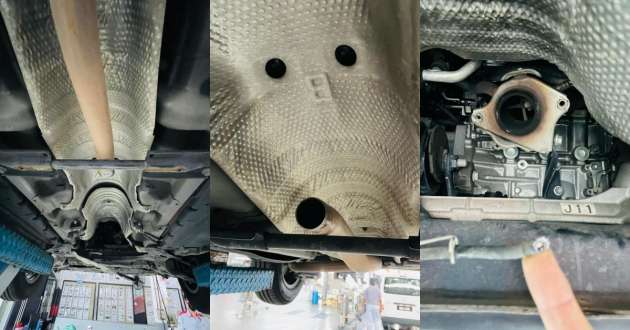Some of you might be aware of thieves stealing catalytic converters in Malaysia, something that has been happening with increasing frequency lately. The catalytic converter is part of a car’s exhaust system, and thieves have been targeting cars parked at LRT/MRT stations to steal them. Each catalytic converter is worth anything from RM500 to RM2,500. Thankfully, police have managed to catch two men involved in various catalytic converters thefts in the Klang Valley. But we don’t know if this is the end.
What is a catalytic converter and why is it so valuable? A catalytic converter is a device used in the exhaust system of vehicles to reduce harmful emissions. It contains a matrix of materials coated with certain catalysts (like platinum, palladium, and rhodium) that promote chemical reactions converting harmful compounds into less harmful ones.
Specifically, it converts carbon monoxide (a poisonous gas) into carbon dioxide, nitrogen oxides (which contribute to smog and acid rain) into nitrogen and oxygen, and unburned hydrocarbons (which contribute to smog) into carbon dioxide and water.
The catalytic converter was first introduced in the United States market in the 1975 model year to comply with tightening regulations on auto exhaust emissions. It was developed in response to the U.S. Clean Air Act of 1970, which set standards to reduce pollutants released by passenger vehicles.
After its introduction in the United States, the use of catalytic converters spread gradually worldwide, driven by tightening emission standards in various countries. However, the pace of adoption varied significantly depending on the region.
In Europe, for example, catalytic converters didn’t become widespread until the late 1980s and early 1990s, as leaded petrol, which is incompatible with catalytic converters, was still commonly used. In other parts of the world, the adoption of catalytic converters came even later.
Unleaded petrol was introduced in Malaysia in the year 1994. We later fully phased out leaded petrol in 1999, which allowed for the use of catalytic converters in vehicles without the issue of the lead in the fuel deactivating the catalyst.
Leaded petrol is incompatible with catalytic converters because the lead in the fuel can coat the catalyst materials in the converter, which include precious metals like platinum, palladium, and rhodium. This coating essentially “poisons” the catalyst and prevents it from facilitating the chemical reactions that reduce harmful emissions.
The lead interferes with the catalyst’s ability to promote reactions that convert carbon monoxide into carbon dioxide, nitrogen oxides into nitrogen and oxygen, and unburned hydrocarbons into carbon dioxide and water. That’s why the introduction of unleaded petrol was a crucial step in the widespread adoption of catalytic converters in vehicles.
Catalytic converters are often targeted by thieves because they contain precious metals such as platinum, palladium, and rhodium. These metals act as catalysts to help reduce harmful emissions from vehicle exhaust.
Due to their high value, especially with increasing commodity prices for these metals, thieves can sell stolen catalytic converters to scrap metal dealers for a significant sum. Additionally, removing a catalytic converter from the underside of a car can be relatively quick, especially for experienced thieves, making it an attractive target.
#catalytic #converter #thieves #stealing #cars #parked #LRTMRT #stations














